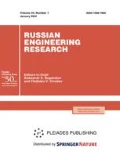Abstract
The wear resistance of the working layer on a grinding belt is studied. The influence of the grinding conditions on the wear resistance is established. The wear of abrasive grains and the failure of the belt’s working layer are analyzed. On the basis of experimental data, the basic cutting parameters corresponding to optimal wear resistance are identified, and efficient cutting conditions are recommended for different materials.



Similar content being viewed by others
REFERENCES
Syreyshchikova, N.V. and Pimenov, D.Yu., Fundamental research and methods of quality assurance of coated abrasive, MATEC Web Conf., 2018, vol. 224, art. ID 01032. https://doi.org/10.1051/matecconf/201822401032
Syreyshchikova, N.V. and Guzeev V.I., Planning the properties of a coated abrasive by quality function deployment, MATEC Web Conf., 2018, vol. 224, art. ID 01026. https://doi.org/10.1051/matecconf/201822401026
Syreyshchikova, N.V. and Pimenov, D.Yu., Quality assessment of emery cloth-based abrasive tool using elasticity technological parameter, Procedia Eng., 2017, vol. 206, pp. 1155–1160.
Axinte, D.A., Kritmanorot, M., Axinte, M., and Gindy, N.N.Z., Investigations on belt polishing of heat-resistant titanium alloys, J. Mater. Process. Technol., 2005, vol. 166, no. 3, pp. 398–404.
Li, H., Li, X., Tian, C., et al., The simulation and experimental study of glossiness formation in belt sanding and polishing processes, Int. J. Adv. Manuf. Technol., 2017, vol. 90, no. 14, pp. 199–209.
Zhao, T., Shi, Y., Lin, X., et al., Surface roughness prediction and parameters optimization in grinding and polishing process for IBR of aero-engine, Int. J. Adv. Manuf. Technol., 2014, vol. 74, no. 58, pp. 653–663.
Xiao, G. and Huang, Y., Equivalent self-adaptive belt grinding for the real-R edge of an aero-engine precision-forged blade, Int. J. Adv. Manuf. Technol., 2016, vol. 83, no. 912, pp. 1697–1706.
Hou, B., Wang, Y., Wang, F., et al., Research on belt grinding for marine propeller blade based on the second-order osculation, Int. J. Adv. Manuf. Technol., 2015, vol. 80, no. 912, pp. 1855–1862.
Syreyshchikova, N.V., Pimenov, D.Yu., Mikolajczyk, T., and Moldovan, L., Technological support of abrasive manufacturing of products on a flexible basis by evaluating performance indicators, Procedia Manuf., 2020, vol. 46, pp. 38–43.
Novoselov, Y., Bratan, S., and Bogutsky, V., Analysis of relation between grinding wheel wear and abrasive grains wear, Procedia Eng., 2016, vol. 150, pp. 809–814.
Kozlov, A.M., Kozlov, A.A., and Vasilenko, Y.V., Modeling a cylindrical surface machined by a non-circular face tool, Procedia Eng., 2016, vol. 150, pp. 1081–1088.
Álvarez-Núñez, L.C. and Flores-Hernández, R.B., Free upper-disk rotational speed under loose abrasive grinding in conventional machines, Optik, 2010, vol. 121, no. 2, pp. 195–205.
Pandiyan, V., Caesarendra, W., Tjahjowidodo, T., and Tan, H.H., In-process tool condition monitoring in compliant abrasive belt grinding process using support vector machine and genetic algorithm, J. Manuf. Process., 2018, vol. 31, pp. 199–213.
Wang, W., Salvatore, F., Rech, J., and Li, J., Comprehensive investigation on mechanisms of dry belt grinding on AISI52100 hardened steel, Tribol. Int., 2018, vol. 121, pp. 310–320.
Shatko, D.B., Lyukshin, V.S., and Strelnikov, P.A., Development of innovative approach to diagnosis of coated abrasive surface, IOP Conf. Ser.: Mater. Sci. Eng., 2020, vol. 843, art. ID 012011.
He, Z., Li, J., Liu, Y., and Yan, J., Investigation on wear modes and mechanisms of abrasive belts in grinding of U71Mn steel, Int. J. Adv. Manuf. Technol., 2019, vol. 101, nos. 5–8, pp. 1821–1835.
Syreyshchikova, N.V. and Pimenov, D.Yu., Wear of a flexible abrasive tool, J. Frict. Wear, 2019, vol. 40, no. 2, pp. 139–145.
Funding
Financial support was provided by the Russian government (decree 211, contract 02.А03.21.0011).
Author information
Authors and Affiliations
Corresponding authors
Additional information
Translated by B. Gilbert
About this article
Cite this article
Syreyshchikova, N.V., Pimenov, D.Y., Kaplonek, W. et al. Operational Wear Resistance of a Grinding Belt. Russ. Engin. Res. 41, 157–161 (2021). https://doi.org/10.3103/S1068798X21020192
Received:
Revised:
Accepted:
Published:
Issue Date:
DOI: https://doi.org/10.3103/S1068798X21020192




